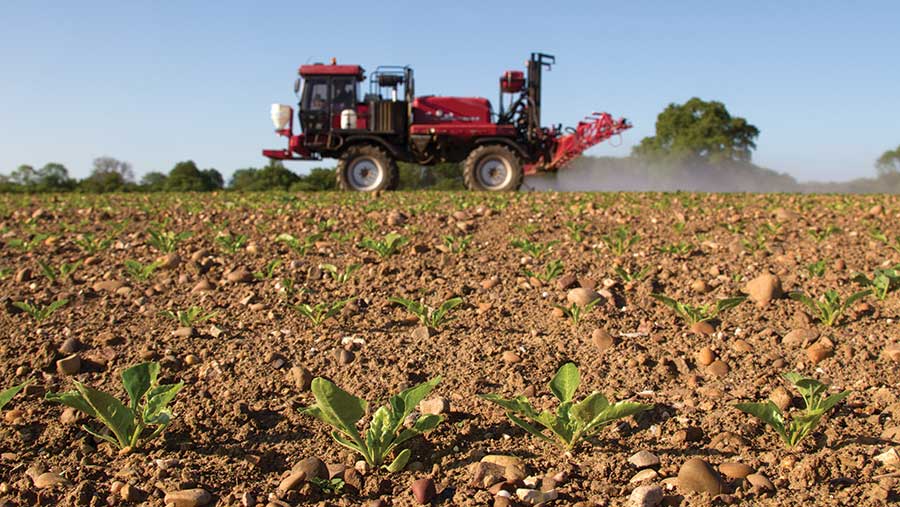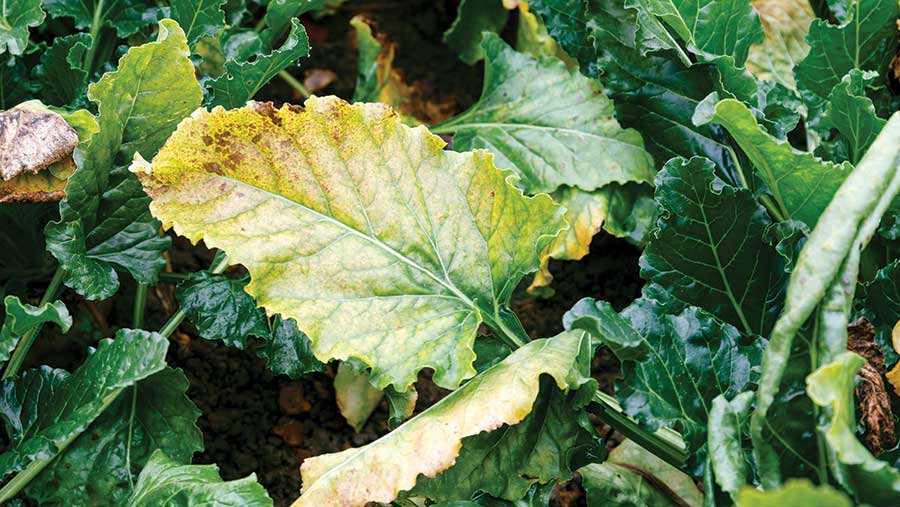Tips on using foliar sprays to control virus yellows in beet
 © Tim Scrivener
© Tim Scrivener Timing will be critical in getting the most out of foliar insecticides this spring, with sugar beet crops facing a high threat from virus yellows.
The peach potato aphid is the main vector for spreading the virus in sugar beet which can cause yield losses of up to 40%. Before they were banned in 2018, growers managed the problem with neonicotinoid seed treatments.
Growers now have to rely on foliar sprays and there is only one fully approved product, Teppeki (flonicamid), which can be applied once per crop at a rate of 0.14kg/ha.
See also: 4-point plan to control virus disease in sugar beet
However, thanks to two emergency approvals, beet growers will also have up to two additional applications of Biscaya (thiacloprid) and one of InSyst (acetamiprid).
For some growers, however, a shortage of Biscaya means they may have a maximum of only two sprays (Teppeki and InSyst), so will need to make the most of them.
Spray timing
So how can growers make their applications count? Stuart Harder, technical account specialist for the eastern region with Belchim, which manufactures Teppeki, says timing is key.
The threshold for spraying is one green wingless aphid/four plants up to the 12-true leaf stage of the crop.
He says: “If you go early, you can waste a few days of efficacy and if you go late, they then have time to build up and potentially spread the virus.”
When monitoring crops, it’s important to know where to find the wingless aphids, he says, as they are not evenly distributed across a field.
Instead, they tend to be concentrated near hedgerows on the headland or in dips and hollows.
“They are not good flyers and if you have a ridge in the field, they will be blown off into the hollows.

© Blackthorn Arable
“Hedgerows are also important because that’s where they overwinter, flying into crops.”
Once crops reach the threshold, then spray the whole field, he advises.
Other tips
If growers are looking to add an adjuvant, the insecticide can then only be applied at full rate up to the six true leaves stage, but growers should check all labels carefully for details.
Volume wise, Mr Harder advises sticking with the standard 200 litres/ha to ensure good coverage of the plants.
The British Beet Research Organisation is running its water pan network, and once growers see reports of flying aphids in their area, they need to regularly monitor their crops.
They need to look for any emergence of wingless aphids, as these are what growers are targeting with foliar sprays.
From a resistance point of view, risk is reduced by the use of other modes of action. Some growers will have some Biscaya and there is also InSyst, so they can alternate the different actives.
2020 forecast and BBRO aphid monitoring network
The virus yellows threat will be earlier and much greater this year than last, according to the British Beet Research Organisation’s forecast.
It predicts that the mild winter means 70-90% of untreated crops will be affected by the virus.
This worst case scenario is much higher than the 2019 forecast of 22-54% of the crop being affected in the absence of any control measures.
The actual 2019 situation showed that although 55% of crops had shown symptoms, the overall level in crops was only 1.8%.
Virus yellows forecast for 2020 |
||||
|
Location |
Drilling date |
Mean temperature (Jan-Feb) |
||
|
15 March |
30 March |
15 April |
||
|
East: (Bury, Cantley, Wissington) |
72% |
82% |
91% |
6.53C |
|
North: (Newark) |
80% |
89% |
95% |
6.51C |
Aphids have already been reported and the British Beet Research Organisation’s monitoring network of yellow pan traps went live earlier this week.
“This is 3-4 weeks earlier than in a normal year,” says BBRO head of science Mark Stevens, who adds that conditions are currently ideal for aphids to build up.
“Aphids are now flying and approaching the treatment threshold in crops in Cambridgeshire,” he says.
The yellow pan network covers 50 sites across the four sugar beet factory areas.
However, because of the coronavirus only water pan samples taken from the BBRO trial sites will assessed in the laboratory for winged sugar beet aphids and their virus content.
For all other sites, operators will submit photographs of the pan contents, says Prof Stevens.
Also new this year is that operators will conduct counts of green wingless aphids in crops with the information being collated by the BBRO, along with the pan network results.
This data will provide an early warning for growers and agronomists to check their crops and monitor numbers for when they reach the threshold of one wingless aphid per four plants up to the 12-true leaf sage.
Beet growers can find the live reports at the BBROPlus web page.
Foliar spray options for spring 2020
Emergency approvals have been granted for the use of InSyst (acetamiprid) and Biscaya (thiacloprid) in sugar beet.
This takes the total to four possible applications – one of InSyst, two of Biscaya (thiacloprid) and one of Teppeki (flonicamid) in growers’ armoury for this year.
BBRO’s Mark Stevens says limiting the spread of virus yellows will be a challenge. “First sprays will be going on soon and it’s likely growers will need to continue protecting crops until late June or early July. Some may need more than three sprays.”
This presents a challenge in resistance management as Biscaya and InSyst are neonicotinoids and have the same mode of action.
The advice is to begin with a neonic – either Biscaya or InSyst – then switch to Teppeki for the second spray and back to a neonic for the third.
If a fourth spray is needed, it will have to be another neonic, which he admits is not ideal, but the only option.

